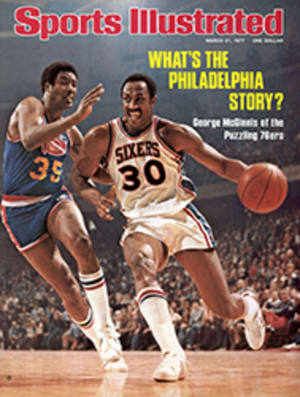
RIGHT UP THE VIEWERS' ALLEY
Bowling for Dollars is televised sport's answer to Let's Make a Deal. Under whatever name you see the show—different versions appear nightly in 16 different cities—the contestants are straight out of the Tuesday-night league at the local lanes, and the bowling is therefore about what you'd expect. The fast-talking hosts spend most of their time soothing the nerves of camera-struck bowlers. The small studio audiences, composed almost exclusively of friends and relatives of the contestants, sit in blocs of seats that look like the Peanut Gallery on Howdy Doody. Unquestionably, Bowling for Dollars is lowbrow. It's cornball. It's also hugely successful. Last year one million people applied to appear on the show. Almost five million watch it every evening. And these are not the only signs of popularity.
•In Baltimore, where it originated as Duckpins and Dollars, the program is now in its 18th season.
•In 1973 and 1974, Bowling for Dollars beat Walter Cronkite, Lucille Ball and What's My Line in Los Angeles TV ratings.
•When it first went on the air in Boston, Candlepins for Cash attracted a 40% share of the 5:30 p.m. viewing audience, providing the news on WNAC with such a strong lead-in that it moved from last place to first in the local ratings.
What is the attraction of Bowling for Dollars? Not sports action, certainly, because on each half-hour program the seven contestants actually bowl only about a minute apiece. There are no celebrities and the winnings are minuscule, averaging $1,800 a week a city. Nor is variety one of Bowling for Dollars' strengths. Its format is unalterably fixed. A contestant is introduced and chats for a minute with the host, then moves to the Pin Pal barrel and picks a card from among those sent in by viewers. (If the bowler wins, the Pin Pal gets half the prize.) Finally, he or she gets to roll a ball down an alley. (One night there are four women and three men; the next night the ratio is reversed.)
The main reason for Bowling for Dollars popularity would seem to be that a lot of people enjoy watching just plain folks like themselves on television. And in seven cities the show is often live, which adds an element of unpredictability. One night Bob Gamere, host of the Boston show, asked a contestant what he did all day. "I make nipples," the steelworker replied. And in nearly every city, at one time or another, a bowling ball has come off a contestant's hand on the back-swing and gone flying in the wrong direction. So far the studio audiences have escaped injury.
"When Bowling for Dollars starts in a new location, it takes a while for people to get in the habit of watching it," says John Claster, who is in charge of the program's syndication. "It takes time for enough people to appear on the show, get their money and tell their coworkers about it. Our ratings almost always double after the first few months."
Bowling for Dollars has been in the Claster family since 1956, when John's father Bert thought up the format as an advertising vehicle for a Baltimore beer company. The elder Claster already had credentials as a promoter, having helped discover Jerry Lewis and launch his career at the Hippodrome Theater. He also conceived, produced and syndicated the long-running Romper Room series—his wife was the show's original teacher, Miss Nancy—and produced the country's first disco show, Teen Canteen.
Duckpins and Dollars appeared once a week until 1968, when it went daily. In the fall of 1971 national syndication was started with a second show in Milwaukee. The next summer Los Angeles was added, and by early 1973 Bowling for Dollars was No. 1 in its time slot in the second-biggest TV market in the country. "The key to people accepting the show as more than just a fluke in Baltimore was getting to the top in the L.A. ratings," says John Claster. Stations in 27 cities have broadcast the show, including 16 of the country's 25 largest markets.
Many Bowling for Dollars hosts have sports backgrounds. Gamere took over Candlepins for Cash after broadcasting play-byplay of New York Yankee games. Chick Hearn, the voice of the Lakers, hosted the Los Angeles show for four years. Dallas' Verne Lundquist covers the Cowboys and announces college football games for ABC.
In each location the format allows minor tailoring to local bowling preferences. Candlepins is the game on the Boston version, and an unusual five-pin variation is shown in Kitchener. Ontario. Baltimore is the only city where the contestant has a choice of games; the left-hand lane is for tenpins, the right-hand one for duckpins. Regardless of the game, the object of the shows is the same: the bowler gets the jackpot by rolling strikes. In Kitchener it takes three in a row to win. On the shows that use tenpins, two consecutive strikes are required, and for duckpins and candlepins a bowler has to get a strike on his first try. On most shows the jackpot starts at $200 and increases by $20 each time a contestant fails. In a few cases it has grown as large as $7,800. Moreover, in Boston a spare is worth $60 and in New York the first strike nets the bowler $100.
Even if the contestant doesn't roll a strike or a spare, he (and his Pin Pal) still get a dollar each for every pin he knocks down. That, at least, pays for a milk shake (all right, a beer) on the ride back home, which suits most losers fine. After all, they've been on TV for a few minutes, which makes them celebrities at the bowladrome on Tuesday.
PHOTO
NEW YORK BOWLER DEBORAH O'DONNELL DOWNED EIGHT PINS

